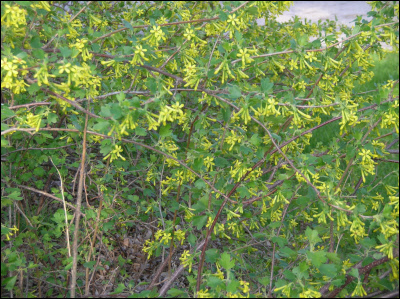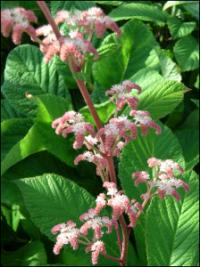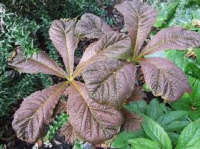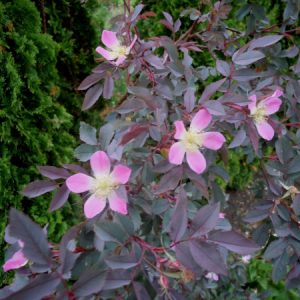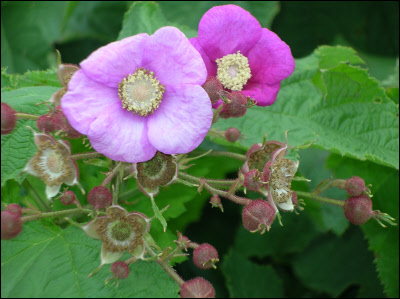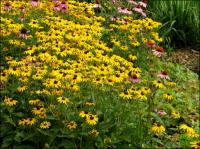Shop
Showing 609–616 of 778 results
-
Ribes aureum syn. Ribes odoratum Clove currant Z 3-8
yellow flowers smother the shrub
Early to mid-spring yellow flowers smother the shrub, giving off the most sweet, clove-scented fragrance – heavenly.
Size: 6' x 6'
Care: Sun in moist well-drained to well-drained soil. Immune to Walnut toxins.
Native: west-central US
Wildlife Value: attracts hummingbirds and butterflies.Found by Meriwether Lewis in 2 locations -“near the narrows of the Columbia.” April 16, 1806, now Klickitat County, Washington, and on July 29, 1805 in Montana. Many different tribes ate the berries – Blackfoot, Cheyenne, Klamath, Montana, Paiute & Ute. Others, Shoshone and Paiute, used the shrub’s inner bark to heal sores and swellings. English plantsman Wm. Robinson declared that it “deserves to be more commonly grown.” (1933)
**LISTED AS OUT OF STOCK BECAUSE WE DO NOT SHIP THIS ITEM. IT IS AVAILABLE FOR PURCHASE AT OUR RETAIL LOCATION.
-
Rodgersia aesculofolia Finger-leaf rodgersia Z 5-7
Showy, fragrant, pink-tinged, ivory flowers along stems rising up to 2’ over basal foliage. Come for the flowers and stay for the foliage - 12” wide bronze-tinted, crinkled, double-tooth edged, palmate shaped of seven leaflets radiate like spokes of a wheel.
Showy, fragrant, pink-tinged, ivory flowers along stems rising up to 2’ over basal foliage. Come for the flowers and stay for the foliage – 12” wide bronze-tinted, crinkled, double-tooth edged, palmate shaped of seven leaflets radiate like spokes of a wheel.
Size: 3-5’ x3-5’
Care: sun to part shade in moist well-drained to wet soil
Native: northern ChinaFirst collected in Sichuan province, China by Siberian Grigorii Potanin (1835-1920) in 1884. Trudy Imp. S.-Peterburgsk. Bot. Sada vol 13 p. 96 (1893). For his political activity as a Siberian separatist Potanin spent years in Russian prison. An accomplished geographer and naturalist he explored much of Kazakhstan and Mongolia and parts of China. In 1879-1880 he explored northern Mongolia collecting many plants and animal specimens.
-
Rodgersia pinnata Rodger’s flower Z 5-8
July-August pink, sometimes white, panicles top crinkly, lance-shaped, palmate leaves
July-August pink, sometimes white, panicles top crinkly, lance-shaped, palmate leaves
Size: 3' x 30"
Care: shade in moist soil
Native: China
Wildlife Value: deer resistant.
Awards: England’s Royal Horticultural Society Award of Merit & Elisabeth Carey Miller Botanical Garden Great Plant PicksRodgersia named for American Admiral John Rodgers (1812-1882) who led an expedition in the Pacific in 1852 during which the 1st species of this genus was discovered. This species introduced from its native China by Ernest “Chinese” Wilson (1876-1930) by 1910.
-
Rodgersia podophylla Bronze-leaf rodgersia In China: gui deng qing Z 5-8
Blooming, creamy white panicles in summer, atop five leaflets, shield-shaped, jagged incisions at the ends forming a palmate shape.
Blooming, creamy white panicles in summer, atop five leaflets, shield-shaped, jagged incisions at the ends forming a palmate shape.
Size: 3-5’ x 3-4’ and slowly spreading by rhizomes.
Care: part shade in moist to moist well-drained acidic soil
Native: woodland & stream edges in Japan, China & Korea
Awards: Elisabeth Carey Miller Botanic Garden, Great Plant Pick Award.Rodgersia named for American Admiral John Rodgers (1812-1882) who led an expedition in the Pacific in 1852 during which this plant was collected. 1st mentioned in literature 1858. Named by Harvard botanist Asa Gray. Species name from the Greek for foot (podos) and leaf (phyllon).
-
Rosa rubrifolia syn. Rosa glauca Z 3-9
Medium pink single blooms in spring. Purplish foliage bearing red-purple hips in autumn.
OUT OF STOCK – EMAIL FOR AVAILABILITY
Medium pink single blooms in spring. Purplish foliage bearing red-purple hips in autumn.
Size: 7’ x 5’
Care: Full sun to part shade in moist well-drained soil. Disease resistant. Japanese beetles seem not to be interested in this rose.
Native: Central Europe
Awards: Plant Select; Elisabeth Carey Miller Botanical Garden Great Plant Pick & Great Plants for Great Plains; Royal Botanical Society Award of Garden MeritIn garden cultivation since 1830
**LISTED AS OUT OF STOCK BECAUSE WE DO NOT SHIP THIS ITEM. IT IS AVAILABLE FOR PURCHASE AT OUR RETAIL LOCATION.
-
Rubus odoratus Flowering raspberry Z 2-8
Purple-pink saucer shaped flowers all summer
Purple-pink saucer shaped flowers from June to October. Rarely seen shrub.
Size: 7-8' x 8' spreading
Care: Sun to shade in moist well-drained soil. Slightly acidic.
Native: Maine to Michigan, south to Illinois, Tennessee, east to North Carolina and all places in between
Wildlife Value: Immune to walnut toxins.For sale in an English catalog in 1730. William Robinson, father of the mixed perennial garden, praised the flowering raspberry as bearing “large clusters of rich purple flowers. Bearing scented leaves, the leaves and not the flowers being fragrant.”
-
Rudbeckia fulgida Black eyed susan Z 4-9
The classic Black-eyed susan, 3" wide yellow daisies with a dark center from July-October
The classic Black-eyed susan, 3″ wide yellow daisies with a dark center from July – October
Size: 30" x 18"
Care: full sun to part shade in moist well-drained to well-drained soil
Native: Southeastern U.S.
Wildlife Value: A great number of bees, flies and beetles collect pollen or drink nectar from this RudbeckiaThis species fulgida was introduced to England in 1760 and named in William Aition’s Hortus Kewensis, V. 3 p. 251 (1789). Cherokee ate the stems and leaves and also used this species to remedy earaches, sores, flux, venereal disease, snakebites, dropsy, and swelling. Iroquois healed the heart and rid children of worms with this, Potawatomi make a brown dye with this.
-
Rudbeckia laciniata ‘Herbstsonne’ Rudbeckia nitida ‘Herbstsonne’ syn. Rudbeckia ‘Autumn Sun’ Z 5-10
Exceptionally large & drooping petals, with a tall, central cone of green, blooms July to September.
Exceptionally large & drooping petals, with a tall, central cone of green, blooms July to September.
Size: 4-7’ x 2-3’
Care: sun to part shade in moist well-drained soil
Wildlife Value: provides butterfly nectar and seeds food for birds
Awards: Royal Horticultural Society Award of Garden MeritIt’s “an old selection.”

